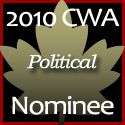Democracy has proved only that the best way to gain power over people is to assure the people that they are ruling themselves. Once they believe that, they make wonderfully submissive slaves – Joseph Sobran (American journalist and author of The Myth of Limited Government)
Sobran's quote neatly sums up the neoconservative approach to democracy. They know that a country's citizens would not support their autocratic intent, so the trick is to allow them to believe that they have a say, while making sure that they have no say at all.
Stephen Harper once shocked journalists back in the day when the Reform Party was being sold as a grassroots movement. I can't remember the exact quote, though I have it somewhere; but the implication was that Preston Manning had to frame messages to make his followers believe that the messages came from them and not him.
Many eventually did catch on, and complained that all the real power in that party was in the hands of what they referred to as the 'Calgary Clique', which included Harper as Manning's lieutenant. If you've ever read George Orwell's Animal Farm, you'll get the picture.
There was an article in The Mark yesterday, by Shauna Sylvester, headlined; Canada's Crumbling Democracy, with the suggestion that we should be cheering for our athletes in Vancouver, but we shouldn't forget about the looming crisis in Stephen Harper's Ottawa.
Sylvester has lived and worked in countries without democracy and recognizes the signs. She says:
Some of the early warning indicators are:
• Limits on the media and the erosion of free speech
• The development of policy without consultation
• The centralization of power
• Limits placed on the activities of public servants
• Quelling or squashing dissent
Canada has already undergone all of these early warning indicators and then some.
The Gig is Up
James Travers had another excellent column this week, as I think he may have experienced a light bulb moment.
Our media, including Travers, had gotten it completely wrong. They had been viewing the Harper government through the conservative lens, so often found themselves shocked or puzzled by their actions.
For me it was like listening to a hockey commentator at a Blue Jays game. They just didn't understand the plays.
Travers writes:
I think they've realized that they didn't need a majority to accomplish their goals. Just a strong will and a compliant media. Travers again:Conservatives are out of their particular closet. Not since ripping into social and legal activists during a first year in power has the party so aggressively, or openly, imposed its ideology. Subtlety is strangely missing in the behaviour of a party tantalized by the prize of turning a minority into a majority. Gone is any serious effort to disguise the motives in Conservative machinations. In its place is the blatant use of money and muscle to discourage and to discipline those judged offside.
When Louis Ranger was forced out of his job at public works, John Baird told him "We don’t want your advice; we want you to do as you’re told." Ranger had been with the department for more than three decades.Whatever the labels, the writing is on Ottawa's walls: To challenge Conservative orthodoxy is to risk reprisals. Even if it's new to non-governmental and arm's-length federal agencies, the message is familiar to bureaucrats and watchdogs. More quietly – but as effectively – Conservatives have been making it clear to civil servants and independent oversight officials that what the Prime Minister wants is mute obedience.
It's All About the Image Baby
One common phrase used by pundits and pollsters when describing Stephen Harper these days, is that he 'looks prime ministerial'. He is the image of what we expect a prime minister to look like.
This is in direct contrast to a statement in the New York Times after Harper's 2006 election victory. They wrote that he "... lacks charisma and looks mad all the time".
The picture on the left is from 2005, which better fits the profile laid out in the NYT.
That's the real Stephen Harper, not the one created by image consultants at taxpayer's expense; who go out of their way to make him look 'prime ministerial'. I think they even died his hair grey, because it seemed to have gone from mousy brown almost overnight.
But the grey hair makes him look more statesmanlike, fatherly and wise; while concealing the fact that he is aggressively pursuing the agenda that scared Canadians away from voting for him in the first place.
This is all part of Image Politics, where a 'leader' is created through images, while the real power lies in the hands of the unelected.
When Paul Calandra's former boss, Mike Harris cabinet minister, Steve Gilchrist, got into trouble when his past revealed charges for tax evasion and alleged fraud, where was Mike Harris? At a photo-op, in a schoolroom surrounded by smiling children.
And the evening news which briefly covered the Gilchrist story, was filled with images of the premier and those children. The media were not even given a soundbite from Gilchrist and he didn't stick around long enough for a decent photo.
Those photo ops defined the government of Mike Harris, just as they are now defining the government of Stephen Harper. (I guess it's no coincidence that Guy Giorno is behind both men).
When Peter MacKay was first put into the hot seat over the Afghan detainee issue, where was Stephen Harper? At a photo-op with the Olympic Lacrosse team.
And when Canadians learned that their sovereignty was traded away for a few crumbs of dry toast, where was Stephen Harper? At a photo-op standing and cheering the Canadian athletes.
And when NATO forces recently bombed the hell out of Afghanistan, killing 27 civilians, where was Stephen Harper? You guessed it. Visual at the Olympics and a pre-taped interview with Wayne Gretzy and Gordie Howe.
The late American historian Daniel Boorstin once wrote: "When images have become more vivid than originals, it is only natural that we should commonly prefer to speak of the more vivid copy."
Touche!




No comments:
Post a Comment